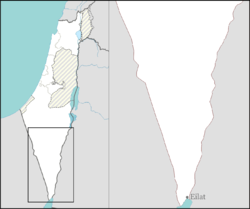|
Be'er Ora
Be'er Ora (Hebrew: בְּאֵר אוֹרָה) is a community settlement 19 kilometers north of Eilat in the far south of Israel.[2] Located in the Arava region, just west of Highway 90, north of kibbutz Eilot, and south of Elifaz and Timna Park, it falls under the jurisdiction of Hevel Eilot Regional Council. In 2022 its population was 1,231.[1] History Before the settlement was founded, Be'er Ora was previously the site of an Israeli army base. In 1968, Be'er Ora was the site of the bombing of a school bus carrying Israeli high school students, an incident that led to Israeli Defense Forces retaliating against a Palestine Liberation Organization base in neighboring Jordan in the Battle of Karameh.[3] The current Be'er Ora settlement was founded in 2001 as part of a program to populate the Arava and to bring people from central Israel to the Negev, which was determined to be a preferred place for new settlement. Previously there was a Gadna army base, also called Be'er Ora, in that location. The word "Be'er" means "well of water". Before the community was established, there was a well within its area that served as the first source of freshwater for Eilat, before Eilat was connected to the national water network. The word "Ora" (light) is borrowed from the nearby Ora Mountain and Ora Creek.[citation needed] AviationIn 2004, the government decided to move the activity of Eilat Airport to a then empty area near Be'er Ora. Ramon Airport opened in 2019. ReferencesWikimedia Commons has media related to Be'er Ora.
|
||||||||||||||||||||


